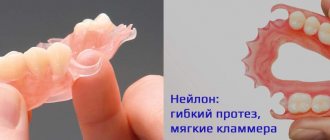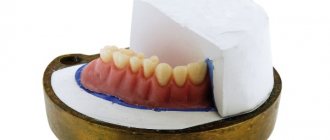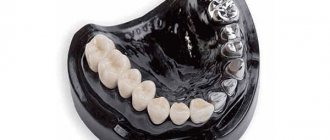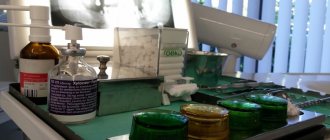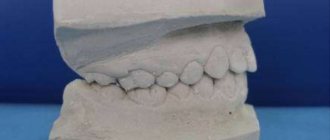Are you worried about the safety of your family budget and at the same time need to install dentures? There are inexpensive but durable orthopedic structures - dentures made of acrylic plastic. Acrylic is a composite, dentures from which are used in cases of complete or partial absence of teeth. A qualified specialist is able to select a model that best matches the shade of the patient’s teeth and gums.
Types of acrylic dentures
Complete removable acrylic dentures are the same “false jaws”. The prosthesis can rest on the gum or be fixed on implants installed for this purpose. Indications for installation:
- complete absence of teeth
- installation of fixed dentures is not possible
Partially removable acrylic dentures are used in the absence of several dental units in a row. They are attached to the supporting teeth using clasps or beam structures. Pre-abutment teeth are ground down or replaced with implants in case of poor condition.
What is the secret of the popularity of acrylic plastics
Today, plastics are no longer used for veneering crowns and bridges as widely as before. Porcelain and modern composite materials will gradually replace cheap plastic, but will not completely replace it due to economic benefits. The properties of acrylic plastics were overestimated immediately after the material appeared on the market. Over time, a harmful effect on the mucous membrane and low strength of acrylic were discovered.
Despite the development of polymer technology, over the past few decades, materials based on derivatives of methacrylic and acrylic acid have held the lead in orthopedic dentistry. Acrylic polymers are attractive due to their low toxicity and ease of processing - at low pressure and relatively low temperature. These properties bring them to a high competitive level.
Care
You don’t have to take special care of acrylic dentures. It is important to do this regularly.
It is most important to rinse your mouth every morning and evening, as well as after meals, after removing the denture.
Modern dentists recommend not removing the structure for the first time after its installation in order to get used to it as soon as possible. It is also not recommended today to lower the structure into a glass of water at night. It is better to simply wrap it in a cloth napkin.
It is also important to exclude all kinds of sticky and viscous foods from your diet.
If you feel discomfort when wearing, or the structure is damaged, it is important to contact a specialist who will make adjustments.
Classification of polymers
Polymers used in prosthetic dentistry belong to one of three groups. Each of them is subject to different hygienic, toxicological, aesthetic, and technological requirements.
- Basic, or basic polymers in dentistry are used for the manufacture of artificial teeth and bases for removable dentures.
- Auxiliary - needed for impressions, molding and modeling.
- Clinical polymers include sealants, restoratives, and adhesives.
Types of plastic products
Plastic structures can be of the following types:
- Made by casting, which makes them as similar as possible to natural teeth and completely repeating the shape of a living dental organ.
- Obtained by pressing. This production is much simpler, and therefore the price of such products is lower.
- Removable plastic products are very common, as they can replace dentition with complete or partial edentia.
- Crowns placed temporarily while another permanent prosthesis is being made.
- Permanent dentures that play the role of a lost tooth.
- Full or partially removable structures are quite affordable.
Water resistance and water absorption of polymers
Water resistance is the ability of polymers to retain their properties under prolonged exposure to water. If water gets inside the polymer, it swells, its shape is distorted, and its strength indicators suffer. Moisture resistance is resistance to humid air. Due to absorption, water vapor also causes swelling of hydrophilic materials. However, more often moisture accumulates in the surface layer due to adsorption, penetrating into microcracks.
The water resistance of the polymer is characterized by water absorption. This parameter indicates the amount of water that the material is able to absorb when kept at a temperature of 18-22 ° C for 23 hours. Due to water absorption, the geometric shape of the prosthesis base changes, and the mechanical properties deteriorate. The higher the water absorption, the more susceptible the polymer is to the penetration of microorganisms.
The presence of sorption water in the polymer sharply reduces its strength, hardness, rigidity, and indentation resistance. The polymer loses soluble substances, so its properties change.
Is it possible to repair a prosthesis at home?
An acrylic denture accidentally dropped into a sink or on the floor may crack or break. This can also happen when certain areas are under heavy load during chewing.
The patient can repair a removable denture on his own, but not always. Breakage of the clasp (attached hook) cannot be done by a person without special skills, so in such a situation you need to contact a specialist.
Some patients try to glue a broken prosthesis with conventional adhesives (Moment, PVA, epoxy glue), which is strictly prohibited. After all, such compositions may contain toxic substances that are harmful to the human body and can lead to dermatitis or eczema.
When deciding to repair a prosthesis yourself, it is important to know the following:
- If you glue a structure with PVA, moisture can lead to its softening and rapid divergence of the seam.
- A rubber prosthesis is also not suitable for an acrylic prosthesis. The glue seam should not be elastic, but rather its rigidity is important. If a nylon prosthesis is glued together, the situation is the opposite.
- Using a large amount of hardener relative to the epoxy resin runs the risk of severe irritation of soft tissues from the alkaline amines contained in the hardener.
- Cyanoacrylate super glue can sometimes be used to temporarily repair acrylic dentures. It is advisable to use it when the patient has already made an appointment with a specialist for repair of the structure, but the day of the appointment will come in a few days, during which the patient does not want to go without teeth. In such a situation, super glue is the safest option relative to other types of glue. It is important to carry out gluing as carefully as possible. But the glue seam will also not last long, since it will constantly be in contact with moisture.
There are patients who tried to repair the structure by soldering it. Usually such manipulations are unsuccessful, regardless of whether the patient used polymethyl methacrylate for this.
If the clasp fits very tightly, or vice versa, too loosely, it is also better to entrust the correction of the prosthesis to a specialist. For the bravest patients who decide to do it themselves, it is recommended to use pliers for this. In this case, great caution and constant testing of the structure are important so as not to provoke the hook to break off.
The same applies if you want to avoid chafing. Some patients try to sand the surface of the base using sandpaper or a nail file.
If you are not sure that you will do it well, you should not do it. After all, you can ruin your prosthesis by trying to improve it at home. Repair and correction of a prosthesis is a matter for a specialist.
What is residual monomer
One of the disadvantages of acrylic base polymers is residual monomer. We are talking about the part of the monomer that did not enter into the polymerization reaction. The amount of residual monomer in the polymer depends on the nature of the initiator, the time and temperature of polymerization. Monomers can have a harmful effect on the body, cause inflammation of the prosthetic bed and various allergic reactions, so it is necessary to achieve a minimum content of it in the denture.
In hot-curing plastics there is 0.5% residual monomer, in self-hardening ones its amount can reach 3-5%. The substance has a negative effect on the strength of the material. When this value exceeds 3%, a sharp decrease in strength is observed, water-oil-alcohol absorption increases, and aging accelerates.
Contraindications and possible allergies
The main contraindication to acrylic dentures is considered to be an allergy to the material, which occurs quite often.
The use of this product is prohibited for patients who have an increased gag reflex and expectant mothers with toxicosis (the first three months of pregnancy). The presence of chronic diseases, pathologies in the mouth, untreated viral, fungal and bacterial diseases, caries, gum or dental diseases are also contraindications to the procedure.
An allergy to acrylic manifests itself in the following symptoms:
- gums burn and itch;
- pain is felt at the place of fixation;
- poor or no taste;
- the mucous membrane is dry;
- strong secretion of saliva;
- inflammation on the palate, gums, tongue or mucous membranes.
If the patient exhibits the listed symptoms, he should immediately consult a dentist.
Heat resistance and thermal conductivity
Heat resistance is understood as the maximum operating temperature of a polymer at which the material can withstand a certain load for a given time, maintaining its geometric shape after cooling. Operating temperatures for the use of plastics, grinding and polishing must occur within the heat resistance range, otherwise mechanical changes will occur.
Thermal conductivity, or the ability to transfer heat, depends on the polymer matrix and filler. The indicator increases with increasing molecular weight. These two thermal characteristics affect the shrinkage of the material, the occurrence of defects in the production of prostheses, and comfort during use.
Various physical and chemical processes affect the aging process of polymers. Destruction in them occurs due to exposure to biological media, mechanical stress and strong temperature changes. Destruction causes fragility of dental dentures and loss of their functionality.
Acrylic dentures: advantages and disadvantages
Thanks to their reasonable price and aesthetics, compared to the rubber previously used in prosthetics, acrylic dentures have become perhaps the most popular over the past 10 years - they are lightweight, fit comfortably on the jaw, and do not rub the gums. The manufacturing material, acrylic, allows you to accurately match the color of the prosthesis to the natural shade of the patient’s natural teeth and gums.
Acrylic dentures solve the problem of partial or complete loss of teeth in the upper and lower jaw. Therefore, they are used both by elderly patients who have lost all or part of their teeth, and by young people who have temporary dentures installed to heal the gums after tooth extraction or while permanent dentures are being made.
Acrylic dentures are also used in pediatric dentistry: they prevent the formation of malocclusion if a child’s baby teeth fall out too early and unevenly. They are also popular among elderly patients - they restore chewing and aesthetic function of the jaw for little money.
New trends in the production of base polymers
In the last few years, there has been a tendency to introduce aesthetic fibers into the structure of hot-curing base polymers. They look more advantageous, but they are inferior to the standard ones in terms of physical and mechanical properties. “Veins” in the structure of polymers lead to the formation of microvoids and reduce the density of the material. Oxygen in microvoids increases the number of monomers. Therefore, such polymers with improved aesthetic characteristics should be used only when indicated - in rare cases.
Despite certain disadvantages, acrylic plastics remain the most common material for the production of removable denture bases. Their main advantages are low price, manufacturability and lack of need for expensive equipment.
Installation of acrylic dentures
Before installing a prosthesis, it is important to examine the oral cavity and treat possible diseases, if any. It is also important to examine the patient for contraindications.
Installation steps:
- First stage. The oral cavity and lips are disinfected with special means.
- Second phase. An impression is taken and a primary prosthesis is made based on it. They try it on and reconstruct it if necessary.
- Third stage. Having received the most suitable temporary product, a permanent acrylic prosthesis is made from it.
The installation procedure usually takes place in one visit to the dental clinic.
Approximate prices
Patients, mentioning the advantages of acrylic dentures in their reviews, call prices one of their main advantages. The cost of the design is really low, although it may vary depending on a number of factors:
- Length of the defect and number of missing teeth.
- Material used. Today on the market there are products of Russian, Czech and Japanese production.
- Fixation method. If the structure is installed on abutment teeth, the final price will include the cost of crowns for them.
- The level of the clinic and its pricing policy.
The approximate price range for acrylic dentures is from 15 to 50 thousand rubles per jaw.
Sources:
- Kopeikin V.N. Orthopedic dentistry. Moscow, 2001.
- Mironova M.L. Removable dentures: a tutorial. Moscow, 2009.
- Official websites of dental clinics in Moscow.
Manufacturing process
The production of acrylic structures is characterized by maximum simplicity. The following stages of product creation can be distinguished:
- In dentistry, the patient is diagnosed with the oral cavity and assessed which prosthetic option will be most suitable.
- If necessary, treatment is carried out. You cannot install a removable structure if there are inflammations or diseases in the mouth.
- The doctor makes a cast of the jaw, which is used to create a plaster model, and then the product itself from acrylic.
- The patient tries on the model. If necessary, it is corrected.
The process of making a prosthesis takes a maximum of 7 days, but the adaptation time to it can last up to 30 days. If a person experiences discomfort, feels strong friction, or feels like the model is not made to fit, you should consult a doctor.
Acrylic or nylon: which is better?
| Criterion | Acrylic | Nylon |
| Material hardness | Material is solid | The material is soft, following the contours of the gums and palate |
| Ability to maintain shape | Retains its original shape for a long time | Deformed due to the softness of the material |
| Porosity | The structure is porous, as a result of which bacteria may accumulate in the pores, plaque formation, and an unpleasant odor may occur. | The structure is non-porous, so plaque and odor are practically not formed |
| Toxicity | Over time, toxic substances may be released | Non-toxic material |
| Fixation | Using special adhesives or clasps | Most often using suction |
| Price | Available | High enough |
Thus, both materials have both disadvantages and advantages, so it is better to make a choice in favor of one of them with the help of a qualified orthopedist who can take into account individual factors.
Nylon construction | Acrylic construction |
| Thanks to the elastic frame, the product adheres to the gum as closely as possible. | The material is quite hard. |
| Due to its high plasticity, the product may deform over time. | The shape of the prosthesis is retained for a long time due to the non-plasticity of the material. |
| The material is non-porous and resists the absorption of odors and plaque accumulation. | The structure of the material is porous. Plaque can accumulate, causing an unpleasant odor and sometimes an inflammatory process. |
| The material is non-toxic. | Some time after installation it may release harmful substances. |
| Quite a high cost. | Affordable price. |
| Do not use glue for fixation. | It is allowed to use glue to improve fixation. |
Pros and cons of designs
There are no universal dental structures; each of them has its pros and cons. The advantages of acrylic dentures are as follows:
- Convenience. If acrylic dentures are made correctly, they are very easy to remove and put back on.
- The material is durable yet lightweight.
- Speed of production.
- Good aesthetic characteristics if the color of the crowns is chosen correctly.
- Even distribution of the load when chewing.
- Low cost.
However, acrylic products have many disadvantages. Among them the most mentioned:
- Risk of allergic reactions. They can be caused by both the acrylic itself and the additives included in the base - dyes and others. Allergies can be prevented by modern surface treatment of the product - for example, glass transition.
- Plastic is a porous material, and therefore dangerous from the point of view of bacterial growth. Acrylic absorbs organic substances from food, as a result of which it becomes covered with bacterial plaque. To minimize the risk of its occurrence, careful care is necessary.
- Increased fragility: the structure may break when chewing hard food or falling.
- If clasp fixation is used, the hooks that wrap around the teeth do not always look aesthetically pleasing.
Important! In their reviews, patients often complain that wearing a prosthesis is uncomfortable, it falls out, rubs the gums and can even cause a gag reflex. However, it is not the material itself that is to blame for this, but poor-quality prosthetics, when the orthopedist or dental technician made mistakes.
Acrylic often causes allergic reactions.
